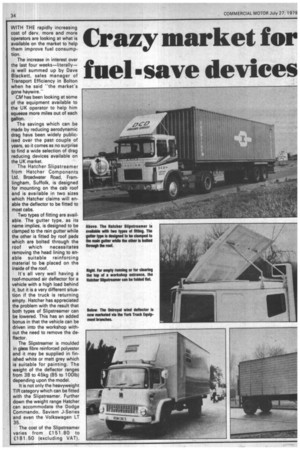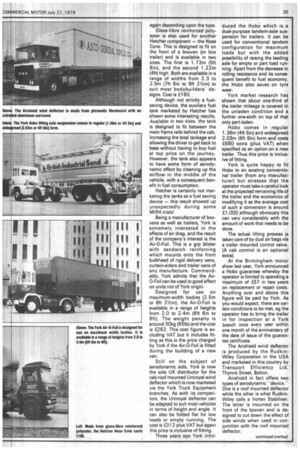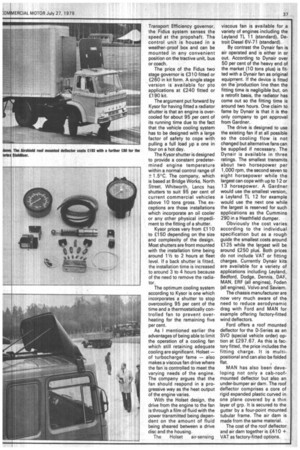Crazy market for fuel save devices
Page 36

Page 37

Page 38

Page 39

If you've noticed an error in this article please click here to report it so we can fix it.
WITH THE rapidly increasing cost of derv, more and more operators are looking at what is available on the market to help them improve fuel consumption.
The increase in interest over the last four weeks—literallyis well summed up by Dave Blackett, sales manager of Transport Efficiency in Bolton when he said "the market's gone haywire."
CM has been looking at some of the equipment available to the UK operator to help him squeeze more miles out of each gallon.
The savings which can be made by reducing aerodynamic drag have been widely publicised over the past couple of years, so it comes as no surprise to find a wide selection of drag reducing devices available on the UK market.
The Hatcher Slipstreamer from Hatcher Components Ltd, Broadwater Road, Framlingham, Suffolk, is designed for mounting on the cab roof and is available in two sizes which Hatcher claims will enable the deflector to be fitted to most cabs.
Two types of fitting are available. The gutter type, as its name implies, is designed to be clamped to the rain gutter while the other is fitted by roof pads which are bolted through the roof which necessitates removing the head lining to enable suitable reinforcing material to be placed on the inside of the roof.
It's all very well having a roof-mounted air deflector for a vehicle with a high load behind it, but it is a very different situation if the truck is returning empty. Hatcher has appreciated the problem with the result that both types of Slipstreamer can be lowered. This has an added bonus in that the vehicle can be driven into the workshop without the need to remove the deflector.
The Slipstreamer is moulded in glass fibre reinforced polyester and it may be supplied in finished white or matt grey which is suitable for painting. The weight of the deflector ranges from 38 to 45kg (85 to 1001b) depending upon the model.
It is not only the heavyweight TIR category which can be fitted with the Slipstreamer. Further down the weight range Hatcher can accommodate the Dodge Commando, Saviem J-Series and even the Volkswagen LT 35.
The cost of the Slipstreamer varies from £151.80 to £181.50 (excluding VAT), again depending upon the type.
Glass-fibre reinforced polyester is also used for another Hatcher component — the Nose Cone. This is designed to fit on the front of a boxvan (or box trailer) and is available in two sizes. The first is 1.73m (5ft 8in), and the second 1 .22rn (4ft) high. Both are available in a range of widths from 2.3 to 2.5m (71t 6in to Bit 21/2in) to suit most bodybuilders' designs. Cost is £160.
Although not strictly a fuelsaving device, the auxiliary fuel tank marketed by Hatcher has shown some interesting results. Available in two sizes, the tank is designed to fit between the main frame rails behind the cab, increasing the total tankage and allowing the driver to get back to base without having to buy fuel at top price on the journey. However, the tank also appears to have some form of aerodynamic effect by cleaning up the airflow in the middle of the vehicle, with a consequent benefit in fuel consumption.
Hatcher is certainly not marketing the tanks as a fuel saving device — this result showed up unexpectedly during some M IRA trials!
Being a manufacturer of boxvans as well as trailers, York is extremely interested in the effects of air drag, and the result of the company's interest is the Air-O-Foil. This is a grp blister with sandwich reinforcing which mounts onto the front bulkhead of rigid delivery vans, curtain-siders and trailer vans of any manufacture. Commendably, York admits that the Air0-Foil can be used to good effect on units not of York origin.
Designed for use on maximum-width bodies (2.5m Of 8ft 21/2in), the Air-0-Foil is available in a range of heights from 2.0 to 2.4m (6ft 6in to 8ft). The weight penalty is around 30kg (651b) and the cost is £262. This cost figure is excluding VAT but it includes fitting as this is the price charged by York if the Air-O-Foil is fitted during the building of a new van.
Still on the subject of aerodynamic aids, York is now the sole UK distributor for the cab-roof mounted Uniroyal wind deflector which is now marketed via the York Truck Equipment branches. As with its competitors, the Uniroyal deflector can be adapted to suit most vehicles in terms of height and angle. It can also be folded flat for low loads or empty running. The cost is £312 plus VAT but again this price is inclusive of fitting.
Three years ago York intro duced the Hobo which is a dual-purpose tandem-axle suspension for trailers. It can be used for conventional tandem configuration for maximum loads but with the added possibility of raising the leading axle for empty or part load running. Apart from the decrease in rolling resistance and its consequent benefit to fuel economy, the Hobo also saves on tyre wear.
York market research has shown that about one-third of the trailer mileage is covered in the unladen condition and a further one-sixth on top of that only part-laden.
Hobo comes in regular 1.36m (4ft Sin) and widespread 2.03m (6ft Bin) form and costs £680 extra (plus VAT) when specified as an option on a new trailer. Thus this price is inclusive of fitting.
York is quite happy to fit Hobo to an existing conventional trailer (from any manufacturer) but stresses that the operator must take a careful look at the projected remaining life of the trailer and the economics of modifying it as the average cost of such a conversion is around £1,000 although obviously this can vary considerably with the amount of work that needs to be done.
The actual lifting process is taken care of by dual air bags via a trailer mounted control valve. (A cab control is an optional extra).
At the Birmingham motor show last year, York announced a Hobo guarantee whereby the operator is limited to spending a maximum of £57 in two years on replacement or repair costs. Anything over and above this figure will be paid by York. As you would expect, there are certain conditions to be met, eg the operator has to bring the trailer in for inspection at a York branch once every year within one month of the anniversary of the date of issue of the guarantee certificate.
The Airshield wind deflector is produced by the RudkinWiley Corporation in the USA and marketed in this country by Transport Efficiency Ltd, Thynne Street, Bolton, Airshield in fact offers two types of aerodynamic "device." One is a roof mounted deflector while the other is what RudkinWiley calls a Vortex Stabiliser. The latter is mounted on the front of the boxvan and is designed to cut down the effect of side winds when used in conjunction with the roof mounted deflector. The wind deflector is made from 9.5mm (Ysin) thick phrenolic fibreboard with an extruded aluminium surround.
Transport Efficiency claims that the purpose-designed mounting brackets make the deflector suitable for most trucks in use in the UK. This choice of mountings also provides for a fixed or fold-down fitting.
The roof-mounted deflector costs £193 with a further £80 for the Vortex Stabiliser (depending upon its size).
Reducing the aerodynamic drag is all very well if the same road speed is used. However, reducing the drag also increases the top speed of the vehicle for a given power output. As an example to illustrate the point, CM carried out some tests with the Airshield deflector in con junction with Golden Wonder some years ago and we found that the maximum speed of the Ford D /York combination increased from 89km / h (55mph) to 97km /h (61mph).
Thus for many operators, the full benefits of a wind deflector can only be obtained in con junction with a road speed governor. Transport Efficiency markets such a device which is designed to operate from either the tachograph or the spee dometer. This can be set to any maximum speed with the only criterion being that the chosen setting is higher than the speed obtainable in the next gear down for obvious reasons.
Transport Efficiency claims that the Speed Limiter cannot be tampered with as any attempt to do so will result in restricted performance in all gears.
The actual mechanics of the operation are taken care of by a solenoid air valve which acts on a piston which in turn restricts the pump rack movement. The cost of the Speed Limiter (which is made by Groenveld in Holland and marketed by Transport Efficiency) is £197 plus VAT and installation.
Another manufacturer involved in the road speed governor market is Fidus Controls Ltd of Heddon Way, Middlefields Industrial Estate, South Shields, Tyne and Wear.
The Fidus system allows full power to be used in the lower gears while restricting the speed in top gear. The mechanical linkages are so arranged that no back movement can be transferred to the throttle pedal even when the pedal is at its full length of travel.
The .governor consists of three units — a speed sensing probe, a control unit and an air cylinder and linkage. Unlike the Transport Efficiency governor, the Fidus system senses the speed at the propshaft. The control unit is housed in a weather-proof box and can be mounted in any convenient position on the tractive unit, bus or coach.
The price of the Fidus two stage governor is £310 fitted or £260 in kit form. A single stage version is available for pto applications at £240 fitted or £190 kit.
The argument put forward by Kysor for having fitted a radiator shutter is that an engine is overcooled for about 95 per cent of its running time due to the fact that the vehicle cooling system has to be designed with a large factor of safety to cope with pulling a full load pp a one in four on a hot day.
The Kysor shutter is designed to provide a constant predetermined engine temperature within a normal control range of -11.5°C. The company, which is based at Bridge Works, North Street, Whitworth, Lancs has shutters to suit 95 per cent of current commercial vehicles above 10 tons gross. The exceptions are those installations which incorporate an oil cooler or any other physical impediment to the fitting of a shutter.
Kysor prices vary from £110 to £150 depending on the size and complexity of the design. Most shutters are front mounted with the installation time being around 11/2 to 2 hours at fleet level. lf a back shutter is fitted, the installation time is increased to around 3 to 4 hours because of the need to remove the radiator.
The optimum cooling system according to Kysor is one which incorporates a shutter to stop overcooling 95 per cent of the time and a thermostatically controlled fan to prevent overheating for the remaining five per cent.
As I mentioned earlier the advantages of being able to limit the operation of a cooling fan which still retaining adequate cooling are significant. Holset — of turbocharger fame — also makes a viscous fan drive where the fan is controlled to meet the varying needs of the engine. The company argues that the fan should respond in a progressive way as the heat output of the engine varies.
With the Holset design, the drive from the engine to the fan is through a film of fluid with the power transmitted being dependent on the amount of fluid being sheared between a drive disc and the housing.
The Holset air-sensing
viscous fan is available for a variety of engines including the Leyland TL 11 (standard), Detroit Diesel 6V-71 (standard).
By contrast the Dynair fan is air operated and is either in or out. According to Dynair over 50 per cent of the heavy end of the market (10 tons plus) is fit ted with a Dynair fan as original equipment. If the device is fitted on the productionline then the fitting time is negligible but, on a retrofit basis, the radiator has come out so the fitting time is around two hours. One claim to fame by Dynair is that it is the only company to get approval from Gardner.
The drive is designed to use the existing fan if at all possible so the cooling flow is not changed but alternative fans can be supplied if necessary. The Dynair is available in three ratings. The smallest transmits about two horsepower per 1,000 rpm, the second seven to eight horsepower while the largest can cope with up to 12 or 13 horsepower. A Gardner would use the smallest version, a Leyland TL 12 for example
would use the next one while the largest is reserved for such applications as the Cummins 290 in a Heathfield dumper.
Obviously the cost varies according to the individual specification but as a rough guide the smallest costs around £125 while the largest will be around £250 plus. Both prices do not include VAT or fitting charges. Currently Dynair kits are available for a variety of applications including Leyland, Bedford, Dodge, Dennis, DAF, MAN, ERF (all engines), Foden (all engines), Volvo and Saviem.
The chassis manufacturer are now very much aware of the need to reduce aerodynamic drag with Ford and MAN for example offering factory-fitted wind deflectors.
Ford offers a roof mounted deflector for the D-Series as an SVO (special vehicle order) option at E297.67. As this is factory fitted, the price includes the fitting charge. It is multipositional and can also be folded flat.
MAN has also been developing not only a cab-roofmounted deflector but also an under-bumper air dam. The roof deflector comprises a core of rigid expanded plastic curved in one plane covered by a thin layer of grp. It is secured to the gutter by a four-point mounted tubular frame. The air dam is made from the same material.
The cost of the roof deflector and air dam together is E410 + VAT as factory-fitted options.








































































































